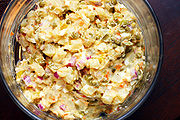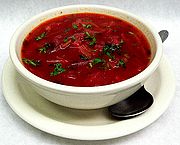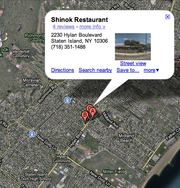From The Peopling of New York City
Contents |
Visiting a Russian Restaurant
Many times one can learn about a particular nation’s history through its food—such is the case with Russia. The Russian cuisine stems mostly from the peasant population that lives in rural areas with harsh winter conditions. Thus, as the nation’s food availability changed due to various economic conditions, so did the menu created by the poor, rural villagers. Traditionally, many Russian dishes are served in bowls in a three-course style menu that begins with appetizers consisting of salads and soups that lead into various meat entrees and, finally, desserts. Due to food being a major part of the Russian culture, it is the first thing that Russian immigrants brought to America and, consequently, is one of the few aspects of the culture that is still upheld by Russian Americans.
Menu
Offering an “Americanized” Russian menu, Café Shinok gives its customers the opportunity to combine traditional Russian food with side orders of French fries, Greek salad, and Caesar salad and, thus, earns itself a more diverse clientele. Additionally, the staff working at this venue speaks both Russian and English. However, the majority of its clientele consists of Russian immigrants and the majority of its menu contains Russian food, which is similar to Ukrainian food. In spite of Russians including many cultures in their food, the restaurant does not include a lot of Georgian food because the majority of Russian people look down upon the Georgians. As a result, the restaurant offers everything from the traditional Russian salad coined Olivie after the French cook Lucien Olivier, who cooked for a czar in the Hermitage restaurant in Russia, to Borscht that was a soup recipe taken from Russians of Ashkenazi Jewish decent. Both entrees can be found in any Russian restaurant and are always a prominent food during special events and New Years Eve celebrations.
Furthermore, both Olivie and Borscht illustrate how the Russian culture has evolved and transitioned over the years. For example, Olivier’s recipe for Olivie was stolen by a competing Russian cook by the name of Ivan Ivanov and then widely commercialized using a few alternate ingredients during the Soviet era. The original Olivie included grouse, veal tongue, caviar, lettuce, crayfish tails, capers gherkins, cucumbers, hard-boiled eggs and possibly soybeans—all of which were the ingredients of the elite and signified prosperity fit for a Czar. The modern day Olivie, created by Ivanov during the Soviet era includes boiled potatoes, dill pickles, peas, eggs, carrots, and boiled beef/chicken or bologna, dressed with mayonnaise. This change of expensive ingredients to cheaper ingredients was due in part to low availability of certain foods to peasants and food in general during Soviet Russia. Conversely, Borscht illustrates the assimilation of certain Russians into American culture. Originally created in Ukraine, this soup is a favorite among the Russians of Ashkenazi Jewish decent and still remains a favorite in communities where there are prominent populations of Ashkenazi Russian immigrants.
Decor
The tradition of Russian cooking is oftentimes perpetuated through Russian women, who are usually the cooks in their families. However, a person does not have to go over a Russian family’s house to enjoy a traditional Russian meal because there are now various Russian restaurants that offer traditional Russian cuisine. One such restaurant is Café Shinok on Staten Island, which is often the place Russian people living on the island frequent when they want a taste of their “home food.” Once one enters this restaurant, he or she will find that everything has a wooden overlay decorated with traditional Ukrainian embroidered towels and that the tables are very similar to the tables and benches used for picnics. This simple décor represents the restaurant’s title, which is the name for a peasant Ukrainian house that is oftentimes also found in Russian villages.
Location
2230 Hylan Blvd
Staten Island, NY 10306
(718) 351 1488
Business Hours
Mon - Thurs: 11:00 am - 10:00 pm
Fri - Sat: 11:00 am - 11:00 pm
Sun: 12:00 pm - 10:00 pm


